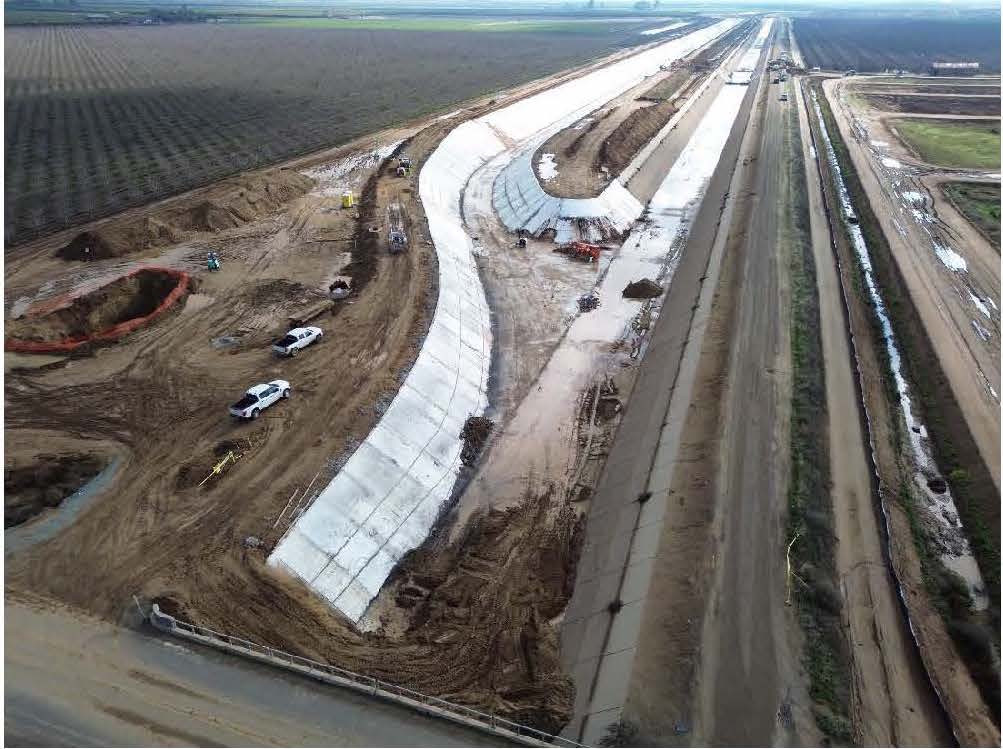Fallout over the ever sinking Friant-Kern Canal could affect growers throughout the Tule subbasin regardless of whether they get water from the canal.
The state Water Resources Control Board already has the subbasin in its cross hairs for neglecting to create a coordinated plan to bring aquifers into balance under the Sustainable Groundwater Management Act (SGMA). A hearing for the Tule subbasin is scheduled for September.
Now, new – and worsened – subsidence (land sinking) beneath the Friant-Kern Canal has prompted the canal’s operator to seek help from the Water Board.
“We’re in a corner so yeah we’re talking to the State Board and we’re asking them to review what’s happening and that we need intervention – soon,” said Jason Phillips, General Manager of the Friant Water Authority, which manages the federal canal and has been the lead agency for a massive two-phase construction project to fix a 33-mile sagging section of the canal.
A major problem
The sag was created by groundwater overpumping, largely by farmers not served by water districts that contract for water from Friant.
Phillips said Friant hasn’t made a formal complaint to the Water Board but it is pointing the board’s attention to the actions of the Eastern Tule Groundwater Sustainability Agency, which covers most of the land along the canal where subsidence is ongoing.
Friant’s contention to the Water Board, and laid out in a recent lawsuit, is that Eastern Tule is allowing its farmers to continue over pumping at such a furious pace that land beneath the newly rebuilt section of the canal is collapsing faster than anticipated – about a foot a year.
Even more concerning, new “cones of depression” from over pumping have been discovered just north of the rebuilt canal. Those new areas of subsidence had not been predicted, nor planned for, during the engineering phase of the approximately $500 million project.
Friant is still trying to figure out how to shore up the newly rebuilt sections of canal and how much that will cost. It has no idea what costs will be to handle the unanticipated sinking further north, said Johnny Amaral, Friant’s Chief Operating Officer.
“This is a major problem,” he said. “We’re four years into the implementation of groundwater sustainability plans and there’s no slowdown in subsidence?
“This has everyone’s attention.”
Local control “failing”
Money to pay for the canal fix has come from water districts that contract for water through Friant as well as some federal and state funding.
Eastern Tule had signed a settlement agreement with Friant four years ago to kick in about $200 million toward the original canal repair costs, but has so far only paid about $16 million.
The bigger problem, though, is the continued sinking, Phillips emphasized.
“We have to do something to protect our canal,” Phillips said. “We don’t have a bulldozer knocking down the canal levees but if we did, we’d have to go to an agency with authority and ask for help. That’s what we’re doing. And really, it’s not that much different from a bulldozer, we’re losing a foot a year.”
Under SGMA the Water Board has the power to take over pumping in entire subbasins even if just one groundwater agency is recalcitrant in making changes.
It’s a specter most agencies have worked to avoid in order to maintain local control.
But that is “failing” in the case of Eastern Tule, Phillips said. “They’re not doing their job to regulate themselves.”
For its part, Eastern Tule has said it is working toward reigning in pumping and complying with SGMA. But that changing grower’s attitudes “is a process,” according to Eastern Tule’s General Manager Rogelio Caudillo.
“It’s not for lack of effort,” Caudillo said. “We have ramped up our communication efforts. We know landowners not knowing this is happening is no longer an excuse.”
Basic info withheld, lawsuit alleges
Besides the Friant lawsuit and potential state action, Eastern Tule is also facing a lawsuit from one of its own landowners, Setton Pistachio.
That lawsuit accuses Eastern Tule of flouting the California Public Records Act by not providing documentation about how the agency calculated and meted out grower credits for groundwater recharge and surface water deliveries within the agency, among other topics.
Setton’s request “merely sought basic information concerning (Eastern Tule’s) compliance with SGMA,” the lawsuit states.
After six months of back-and-forth with Eastern Tule over the records, the agency had not produced a single record, according to the lawsuit, which was filed in September 2023. A case management conference is set for May 20 in Tulare County Superior Court.
A representative of Setton Farms did not return phone calls.
Water accounting questions
How much water Eastern Tule credits to its farmers and how it allows them to use various “types” of water has been a contentious subject.
“Their system is very complicated,” Friant’s Phillips said. “But one of the biggest infractions from our view is that Eastern Tule is the only groundwater agency that allows growers to transfer rainfall credits. That means the rain falls in one part of the GSA and that owner can transfer it to another part of the GSA that’s in overdraft and pump it out there.”
That sort of water accounting has reduced how much Eastern Tule growers pay Friant toward the canal fix.
But more crucially, Phillips noted, it also has also resulted in continued subsidence.
Picking up the slack
As the state process and lawsuits are playing out, other water managers in the region are putting infrastructure projects on the back burner.
In the Tulare Irrigation District, a $57 million infrastructure rehabilitation project has been tempered in order to prioritize payments toward the Friant-Kern Canal, General Manager Aaron Fukuda told a World Ag Expo audience earlier this month.
“Our district was formed in 1889. Things are breaking,” he said. “There are structures that I tell people to avoid because they could fall on them. But we have to make our payments to the canal because if we don’t make those payments, we can’t get our supply.”
He said monies the district assumed would be coming in from Eastern Tule to offset canal construction costs are not materializing, forcing the district to change course.
“I don’t have enough funding for it all. I can’t lose access to my Friant supplies. I have to prioritize that.”
Mike Hagman, general manager of Lindmore Irrigation District in eastern Tulare County, said Lindmore has already funded its initial $2.25 million commitment to the canal fix. But the board anticipated Eastern Tule not coughing up its payments so is collecting another $1.75 million from its landowners for a total contribution of $4 million.
“My board members are not happy with Eastern Tule not following the (settlement) agreement,” Hagman said. “The most critical thing is that we need the canal.”
Share this:
- Click to share on Facebook (Opens in new window)
- Click to share on Twitter (Opens in new window)
- Click to share on LinkedIn (Opens in new window)
- Click to share on Reddit (Opens in new window)
- Click to share on Tumblr (Opens in new window)
- Click to share on Pinterest (Opens in new window)
- Click to share on Pocket (Opens in new window)
- Click to share on Telegram (Opens in new window)
- Click to share on WhatsApp (Opens in new window)
- Click to print (Opens in new window)








